

IPCPovertyInFocus9. War on Poverty - American RadioWorks. When Lyndon B.
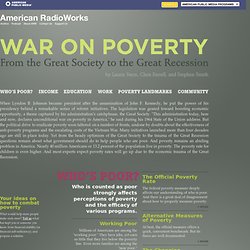
Johnson became president after the assassination of John F. Kennedy, he put the power of his presidency behind a remarkable series of reform initiatives. The legislation was geared toward boosting economic opportunity, a theme captured by his administration’s catchphrase, the Great Society. Poverty in America: A problem hidden 'In Plain Sight' - In Plain Sight. Welcome to the home of “In Plain Sight,” a special initiative by NBC News to report on poverty in America, especially as it appears in forms and in places that many people overlook or choose to ignore.
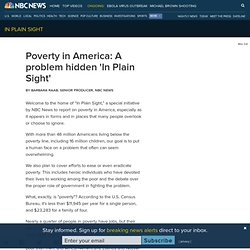
With more than 46 million Americans living below the poverty line, including 16 million children, our goal is to put a human face on a problem that often can seem overwhelming. We also plan to cover efforts to ease or even eradicate poverty. This includes heroic individuals who have devoted their lives to working among the poor and the debate over the proper role of government in fighting the problem. What, exactly, is "poverty"? According to the U.S. Nearly a quarter of people in poverty have jobs, but their pay is so low that they still don't have enough money to meet basic needs like food, shelter, clothing and health care.
The Puzzle of Measuring Poverty. Despite four years of economic distress, the welfare rolls have barely budged, as my article this weekend shows.
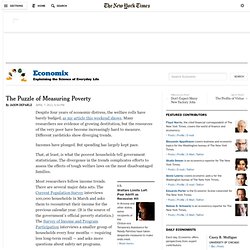
Many researchers see evidence of growing destitution, but the resources of the very poor have become increasingly hard to measure. Different yardsticks show diverging trends. Incomes have plunged. But spending has largely kept pace. That, at least, is what the poorest households tell government statisticians. Most researchers follow income trends. The two data sets show a similar pattern since 1996, when President Bill Clinton signed a tough law placing time limits and work requirements on welfare recipients. What Role is Welfare Playing in this Period of High Unemployment? Abstract Temporary Assistance for Needy Families (TANF), the nation's cash assistance program for poor families with children, has not played much of a countercyclical role during the current recession.
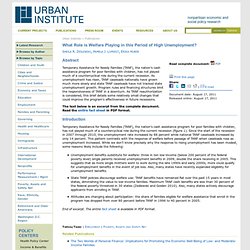
As unemployment has risen, TANF caseloads nationally have grown much more slowly and state TANF caseloads have not tracked state unemployment growth. Program rules and financing structures limit the responsiveness of TANF in a downturn. As TANF reauthorization is considered, this brief details some relatively small changes that could improve the program's effectiveness in future recessions.
NPR Attacks Disability, Bolsters 'New Consensus' Against Welfare. (Image: Disabled woman via Shutterstock) Nearly two decades after Bill Clinton ended “welfare as we know it,” we’re seeing a new push to decimate what’s left of the safety net.

Conservatives and liberals alike who drank the Kool-Aid about the “success” of welfare reform are still waging war on welfare. Now NPR’s Planet Money has joined the chorus with Chana Joffe-Walt’s confused and rhetoric-heavy March 22 piece “Unfit for Work: The Startling Rise of Disability in America.” (Versions also aired on This American Life and All Things Considered.) Liberal policy analysts and progressive media groups have already responded to the inaccuracies in Joffe-Walt’s piece. These stories have been largely right to focus on these issues—access is actually extremely difficult. Moving People From Welfare To Disability Rolls Is A Profitable, Full-Time Job.
Copyright © 2013 NPR.

For personal, noncommercial use only. See Terms of Use. For other uses, prior permission required. Unfit for Work: The startling rise of disability in America. By Chana Joffe-Walt In the past three decades, the number of Americans who are on disability has skyrocketed.
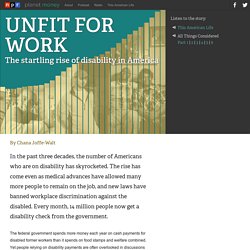
The rise has come even as medical advances have allowed many more people to remain on the job, and new laws have banned workplace discrimination against the disabled. Every month, 14 million people now get a disability check from the government. The federal government spends more money each year on cash payments for disabled former workers than it spends on food stamps and welfare combined. Flashback - The Welfare Debate. May 1995 As the American welfare system comes to an historic pass, we're revisiting a couple of articles that examine many of the same issues currently under debate.

Perhaps the most fundamental of these is the question of whether welfare dependency is the result of too much government assistance to the poor or too little. The question has been debated many times over since the explosive expansion of the welfare state in the 1960s and is precisely the issue Irving Kristol considers in his 1971 Atlantic article, "Welfare: The Best of Intentions, The Worst of Results. " Using the justification for the augmentation of welfare programs made by Frances Fox Piven and Richard A. Along with Kristol's review, we have posted David Whitman's 1987 article, "The Key to Welfare Reform. " The Best of Intentions, the Worst of Results - 71.08. Second, in an "opulent" society the idea of poverty itself undergoes a continual redefinition.
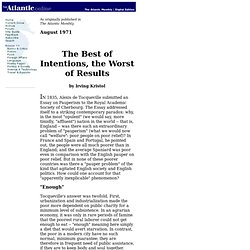
The poor experience not only the need for a guaranteed minimum; they also suffer from what a modern sociologist would call "relative deprivation. " Tocqueville puts the matter this way: Among civilized peoples, the lack of a multitude of things causes poverty. But Tocqueville did not stop with this explanation -- a persuasive and not particularly controversial explanation -- of why wealthy nations have so many "paupers. " He went on to assert that public assistance and "pauperdom" existed in a symbiotic relationship, and he predicted that each would nourish the other, that both would inexorably grow.
At this point, we are bound to draw up short and take our leave of Tocqueville. Mystery Professors Piven and Cloward, both leading "activists" in the Welfare Rights Movement, have written a valuable book -- but, alas, a confusing one. But, eventually, any social phenomenon yields up its mystery. The Key to Welfare Reform - 87.06. More Welfare, More Poverty. News that the poverty rate remained at 12.6 percent last year, statistically unchanged from the year before, has set off a predictable round of calls for increased government spending on social welfare programs.
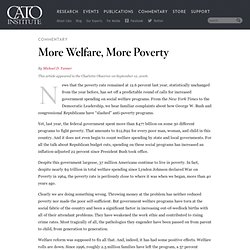
From the New York Times to the Democratic Leadership, we hear familiar complaints about how George W. Bush and congressional Republicans have “slashed” anti-poverty programs. Yet, last year, the federal government spent more than $477 billion on some 50 different programs to fight poverty. That amounts to $12,892 for every poor man, woman, and child in this country.
And it does not even begin to count welfare spending by state and local governments. Despite this government largesse, 37 million Americans continue to live in poverty. Clearly we are doing something wrong. The Real Problem With Welfare: It Stopped Helping the Poor - Jordan Weissmann. Mitt Romney has a new ad out accusing President Obama of attempting to "gut" welfare reform by letting states hand out cash to families that aren't working.